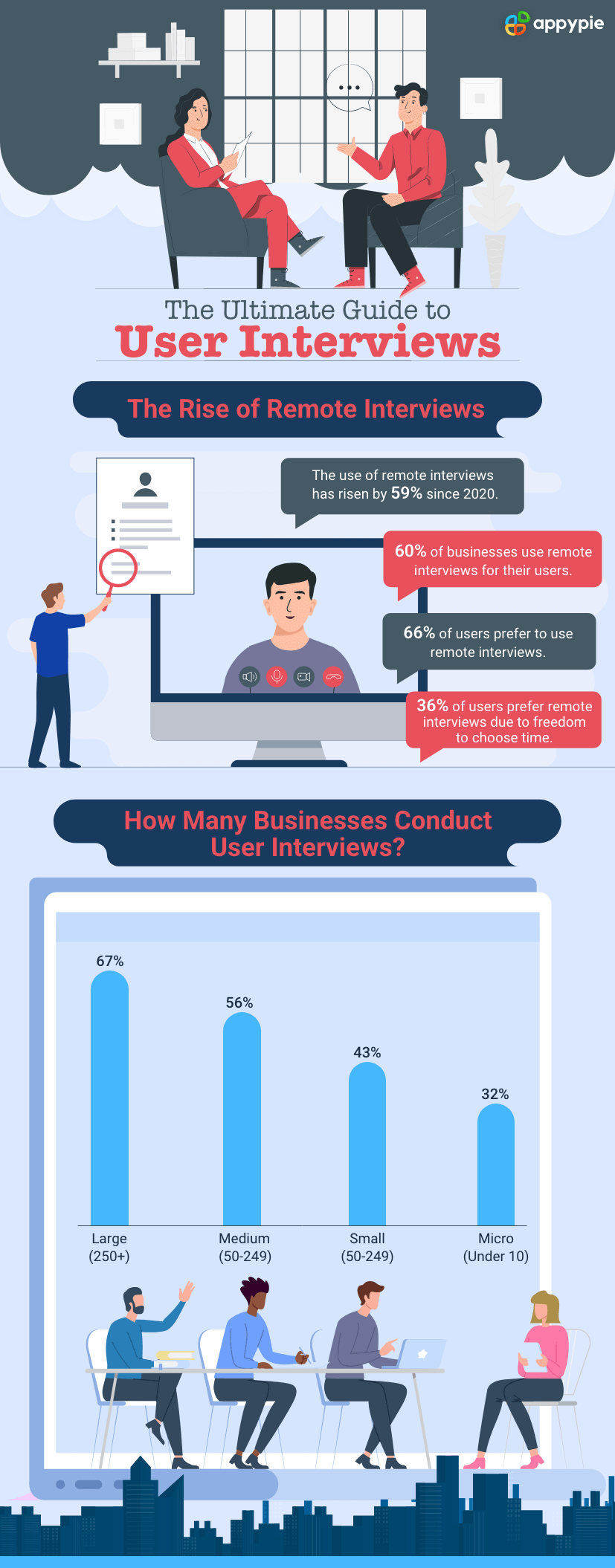The Ultimate Guide to Conducting User Interviews in 2021

By Abhinav Girdhar | Last Updated on October 7th, 2023 10:15 am | 5-min read
You have a great idea, but don’t know if the users will like it. Does this sound familiar? Getting to the gist of what they need is essential for your product’s success. This is because satisfied customers drive more leads and sales, and build social proof to further expand the business.
Table of Contents
Qualitative methods of UX research are usability testing and user interviews and both focus on collecting an in-depth understanding of users. User interviews can make you understand users’ pain points on a deeper level and enable you to provide a comprehensive solution.
 Furthermore, to get ahead of the curve — choosing the right form of user interviews and asking the right questions is essential. That’s why we’d like to share some of the best practices and actionable tips to skyrocket your product design.
Furthermore, to get ahead of the curve — choosing the right form of user interviews and asking the right questions is essential. That’s why we’d like to share some of the best practices and actionable tips to skyrocket your product design.Identify the target audience
First off, start by identifying the audience who would want to use your product. Answering a simple question like "What problem does my product solve?" will provide the basic groundwork for defining your audience. However, by employing some well-thought strategies you can achieve better results in narrowing down your audience precisely. Start by defining the following:- Type of user — B2B or B2C
- Demographics — age, location, job title/employment status, education
- The structure of the competition's audience
Crafting the perfect interview
After finding the right audience, the next critical step is to create a well-structured, straightforward user interviewing questions or a script. Here are a few useful tips to cling to while crafting a perfect interview:- Avoid biases at any cost, along with leading, suggesting, or stacked questions
- Ask the questions that will make users feel like experts and immersed to solve a problem
- Have a clear set of objectives — what are you trying to accomplish?
- Do not stick with script-like questions — allow for some improvisation
- Craft open-ended questions and avoid Yes/No questions
- Feel free to ask common or “dumb” questions
- Avoid business jargon
- Use the “5 whys” technique to get to the core of users’ insights, pain-points or behaviors
- Do not make assumptions
- Avoid asking too many questions
- Understand that questions won’t be enough — they are just the opening to dig deeper
- Clarification
- Rephrasing
- Recalling (past experiences)
- Collecting details
- The actual user interview
The actual user interview
This is the part where the execution happens, and everything you’ve defined thus far is put into practice. Before moving on to the highlight of this phase, the interview with the user, here are a few more things to cover.Logistics and pre-interview communication
Logistics are important for user interviews, especially in 2021, since the world is in the middle of a global pandemic. That’s why you might need to conduct remote user interviews which calls for a different strategy. On the other hand, conducting face-to-face interviews with users require thinking about:- Interviewing location — choose a neutral, relaxed setting without your or any other branding
- Note-taking — Written notes or audio/video recordings of the whole interview
- Ask users for their consent when it comes to recording and using audio/video material made during the interview
- Make a short call before the interview where you'll explain to the user what the interview is for and build initial rapport
Conducting the interview
This is a crucial phase where the interviewer's goal is to have a welcoming, rapport-building conversation with the user and gather the answers/insights for predetermined objectives. Hence, the interviewer should focus on:- Body language and appearance Do not dress too formally, and feel free to show a positive attitude towards the user. Keep it natural, if you feel like smiling, smile!
- Maintaining neutrality Do not judge or react emotionally, especially if you are related directly to a product/service/idea you are interviewing for. Give the interviewee enough space and time — when silence occurs, let it be, do not rush the user.
- Active listening Make the user feel heard and acknowledged. Keeping eye-contact and occasionally nodding will give off those cues, but more importantly "just be there". Precisely, be interested in what the user is saying (without bias) and back up your interest with natural follow-up questions that will arise at the moment.
- Let the conversation flow Yes, you have a script or semi-structured questions to ask, but allow the conversation to drift off to some extent, as this can open doors to spontaneous revelations or insights. Besides, it will make the conversation more natural and organic.
- Be aware of time and moderately leading the interview in the right direction Scripts or pre-set questions will keep you on track. Furthermore, this means balancing the conversation between naturality & spontaneity and directing the conversation towards covering all the key-objectives.
- Closing dialogue You should thank the interviewee for their time and ask whether they have any questions of their own. Let it transition into chit-chat, because it may ultimately lead to some additional insights. You can also explain how you will use the data gathered.
Post-interview analysis
Finally, the last phase is transferring raw data from interviews into meaningful, applicable recommendations. You can do this in multiple ways and the most effective ones include:- Reviewing your findings with team members
- Making empathy maps or user scenarios to effectively organize your findings
- Using a dedicated UX analysis tools
Conclusion
An excellent user interview consists of many successfully conducted phases and each of them is equally important. Every phase requires a specific approach and skills while paying close attention to implementing the main goal behind the interview in each. That's why it is important to have a resourceful team conducting research or outsource it to the experts or sign up for usability testing tools. The advice covered here offers guidance to start the right way and allow for a space to build upon. Feel free to tell us your experience with user interviews in the comments below.Related Articles
- What is Cyber Monday? Tips to Score the Best Cyber Monday Deals
- How to Install Windows 11 from an ISO File: A Complete Guide
- Scarlet Color (#FF2400): A Comprehensive Guide to Its Shades, HEX Code, and Combinations
- Getting Started With App Marketing
- How to Drop a Pin on Google Maps on Mobile and Desktop?
- Doritos Logo: A Glorious History of Little Bits of Gold
- Identity Decoupling for Multi-Subject Personalization of Text-to-Image Models
- Competitive Analysis: A Startup’s Guide to Conquering the Market
- Transforming App Development with Artificial Intelligence
- Blue Color: Exploring the Shades, HEX Codes, and Their Uses
